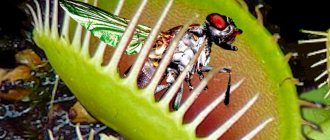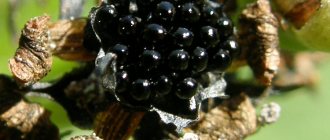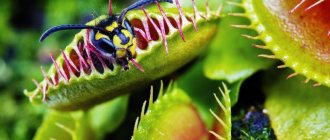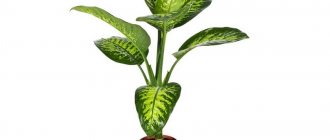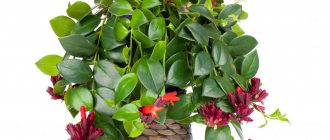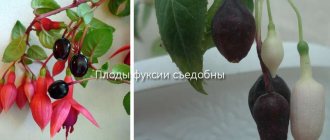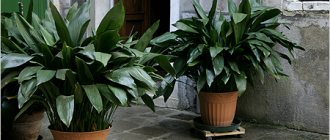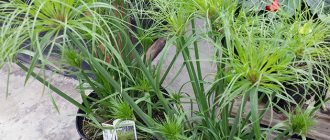The amazing Dionaea flower or Venus flytrap (Dionaea muscipula) is one of the most famous insectivorous plants with a unique trap, and is only one species in nature.
Dionaea muscipula grows in one small region of the world - along the East Coast of the United States in a small part of North Carolina and Southern California.
The flower was discovered in the late 1760s and named after the Greek goddess Dionaea, which explains the scientific name of the genus Dionaea. The species name "muscipula" is translated from Latin as mousetrap.
general description
Under natural conditions, the flycatcher is found in the eastern United States of America, in pine forests in the middle of peat bogs.
It prefers to grow in a humid temperate climate, near the Pacific coast.
The soil in this region has few nutrients, so Dionea adapted in her own way to the proposed living conditions, learning to hunt insects and extract the necessary components from them.
Venus is a low plant (in natural conditions - twenty centimeters in height, in apartments - ten - twelve ). It has four to seven leaves growing from a small underground stem, invisible to the eye.
The long leaves consist of two parts. The lower green part of the leaf feeds on light, and the upper trap provides living food. It consists of two slamming doors with sharp teeth on the edges of each. Inside each valve you can find three setae, as well as scarlet glands that produce insect-dissolving liquid.
The appearance of the plant depends on the time of year: in summer, the traps become large and are painted a bright burgundy color. This is necessary to attract potential victims; insects, seeing the red color, think that the plant has nectar and fall into a trap.
In winter, the predatory flower is in a calm state, so the traps die off, and it seems that the plant has dried up and died.
REFERENCE! The mechanism of eating insects is worthy of attention, although it is quite creepy to watch.
To attract prey, Venus secretes fragrant nectar. When an insect descends into the trap, it touches one of the three bristles. The mechanism does not work immediately, this is a kind of protection against the empty slamming of the doors if, for example, a speck gets into them.
When the insect touches the bristles for the second time, the trap slams loosely, and when it touches the bristles for the third time, it closes completely, not giving the victim any chance of freedom. After this, digestive juice is released, which dissolves the insect within one to three weeks.
IMPORTANT! The stronger and more active the insect tries to get out, the tighter the Venus flytrap will squeeze the death trap.
In late spring and early summer, Dionea blooms with gorgeous snow-white flowers.
A Venus flytrap can live up to twenty years , functioning well.
Reproduction
The Venus flytrap can be propagated in any way - seeds, bulbs, division and even peduncles. It all depends on how quickly the grower wants to get a new bush.
Bulbs
An adult plant has daughter bulbs. Dionaea grows well surrounded by children and weakens if they are often removed. The plant can be propagated in this way no more than once every three years.
Breeding order:
- Separate the onion along with the roots.
- Sprinkle the cut area with chiseled charcoal.
- Plant in a separate container.
- Cover with film until completely established.
Cuttings
This is the simplest and most productive method of reproduction. You will need leaves that do not have traps on them.
Breeding order:
- Cut the leaf and treat the cut with Kornevin (growth stimulator).
- Plant the cutting at an angle of 45 degrees in a container filled with peat and sand (1:1).
- Cover the container with a lid.
Next, you need to carefully care for the cuttings, maintaining the necessary conditions. After 2–3 months, the first shoots grow near the base of the cutting. After another 2–3 months, the plant needs to be transplanted into a pot.
Seeds
This is the longest and most difficult method of reproduction. A plant grown from a seed may not resemble the mother bush.
Seeds for planting are taken from a flower that has reached 2–3 years of age. When the plant blooms, it must be pollinated with a brush or cotton swab. Seeds are collected in the fall from dry capsules. They have limited germination, so it is better to plant them immediately in a container.
Seed propagation order:
- Scatter the seeds treated with Topaz on a damp substrate.
- Cover the container with a transparent lid and leave it close to the sun.
After a month the seedlings grow. After the first leaves appear, the greenhouse begins to be ventilated. After a month, the seedlings are transplanted into pots. A full-fledged plant will emerge from them in 5 years.
Peduncle
Flowering shoots take away strength and can cause diseases in Dionaea. Cut shoots can be thrown away or used for propagation.
How to propagate Dionaea:
- When the peduncle reaches a length of 5 cm, cut it off.
- Stick it into moistened peat and deepen it 1 cm.
- Cover with film.
On a note!
The peduncle will take root in 45–60 days. If it dries out, you should despair; the plant will soon sprout new shoots.
Photo
Below is a photo of a flycatcher:
See the seeds below in the photo:
Look further at the photo of the flowers of the Venus flytrap:
What does the Venus flytrap feed on?
The diet of the flower is very diverse. This includes almost all insects that can somehow get onto the leaf. The only exceptions are very large and strong species. The Venus flytrap “eats” flies, beetles, spiders, grasshoppers and even slugs.
Scientists have identified a certain percentage in the flower menu. For example, a carnivorous plant consumes 5% flying insects, 10% beetles, 10% grasshoppers, 30% spiders. But most often, the Venus flytrap feasts on ants. They occupy 33% of the total amount of digested living creatures.
Venus flytrap catches flies – video
Care
How to care for a Venus flytrap at home?
Exotic plants are increasingly being grown at home. Any person is interested in observing a unique and unique natural organism. Increasingly, the predator flower “Venus flytrap” can be found in ordinary hypermarkets that also sell flowers.
ATTENTION! The Venus flytrap is a very capricious plant for which it is not easy to create suitable conditions.
Lighting
It requires special care at home. It is recommended to place Dionea in a well-lit place. If she has the opportunity to enjoy four or five hours of sunlight per day, the traps will develop well, reaching the largest possible size and intense coloration.
ATTENTION! The plant is shaded from direct sultry rays.
Temperature
Under natural conditions, Dionea lives at the following temperatures: in summer the range is from nine to twenty-six degrees Celsius , and in winter - no higher than seven degrees.
Watering
Dionea is watered not from above, but through a tray, using distilled, melt or rain water . The earthen clod must not be allowed to dry out. In summer, watering is also carried out in the following way: lower the pot into water for twenty to thirty minutes.
ATTENTION! If a gardener collects rainwater, he must keep in mind that it cannot be stored in metal containers for a long time, because it absorbs metal salts that are harmful to Dionaea.
Humidity
It is necessary to maintain a high level of humidity for the plant. Air humidification includes periodic spraying and placing a container of water or moistened fabrics next to the pot. At any time of the year, home Venus is protected from exposure to air currents.
The soil
Inexperienced gardeners can plant indoor flycatchers in universal soil. This is a fatal mistake that will ultimately lead to the death of the plant.
For planting, you need to mix high-moor peat and perlite (proportion 1:1 or 2:1). Before planting, the mixture is well moistened.
Feeding
At home, Venus feeds on any insects caught in the trap. What to feed the Venus Flytrap? There is no need to feed a flytrap located in an open room with insects, but if the need arises (for example, there are no insects indoors at all), you can introduce a live mosquito, spider or fly into the trap (it will not react to a dead creature).
You cannot feed the plant with worms, caterpillars, larvae, bloodworms and meat products.
IMPORTANT! The flycatcher does not require the usual fertilizers applied to the soil by flower growers.
Transfer
Venus is transplanted once every one or two years. It is better to carry out manipulations before flowering begins (late spring). The pot is selected to be deep, and a good drainage layer is installed at the bottom.
Reproduction
Propagated by cuttings, dividing the bush and seeds.
How to plant flycatcher from seeds?
Seeds can be obtained from your own specimen by hand pollinating each flower in early spring. Before planting, the seeds are soaked in Epin or stratified. Then they are planted in prepared soil and a greenhouse is organized, providing sufficient light and high air humidity.
After the first leaves appear, the seedlings are ventilated. One to two months after the detection of seedlings, the sprouts are planted in pots.
Easily propagated using bulbs. In the first month of summer, the main plant produces babies. When their roots grow, you can simply plant them out.
You can learn more about the conditions of keeping the Venus flytrap and the features of care at home in the video below:
How to plant and replant a flower
If a Venus flytrap bush is purchased in a store, it is recommended to immediately transfer it to a new pot with fresh substrate. How to transplant Dionaea:
- Carefully remove the plant from the store pot.
- Carefully shake the roots off the soil. It is advisable to rinse them in warm water, but use only distilled or boiled water.
- Fill a pot 20 cm deep with substrate.
- Place the roots of the plant in the center of the pot and sprinkle them with soil mixture. There is no need to tamp.
- Water the flower and place it in a slightly shaded place.
The flycatcher gets used to the new soil for about a month. At this time, it needs abundant watering and protection from direct sunlight.
Dionaea does not need annual transplants, since the substrate in which it grows does not lose its properties. It does not become depleted, and if properly watered with filtered or boiled water, it does not become salty.
Diseases and pests
Pests practically do not bother the flycatcher, although sometimes it can be attacked by aphids and spider mites.
Yellowed and fallen leaves indicate insufficient watering.
Yellow leaves that do not fall off indicate that the water is too hard.
If the sun has burned the leaves or the grower has applied mineral fertilizers, brown spots will appear on the leaves.
Caring for a fly-eater flower at home
The first thing anyone who purchased this plant needs to know is that Dionaea does not like shade. She needs a lot of bright sunlight. However, there is a small nuance here: in the same way, it does not like heating the soil - its roots do not tolerate it well. Therefore, it is necessary to monitor the temperature of the soil in the pot. To avoid overheating, it is necessary to place the pot of dionaea on a western or eastern window; It is desirable that the pot itself is light. The flytrap plant should not be placed near the north window; it will be dark there.
In the stagnant, musty air, this insectivorous plant withers; therefore, the room must be thoroughly ventilated. In the summer, you can move the pot with the Venus flytrap to an open place - a balcony, garden, etc. In an open place, it will also be easier for the green predator to get food. However, it is worth noting that this plant does not tolerate frequent movements and rearrangements very well - this is stressful for it; therefore, it is better to choose one permanent place for indoor keeping and one additional place for summer keeping.
If the flytrap plant is kept exclusively indoors, then it makes sense to take care of additional lighting, which can be done using conventional fluorescent lamps.
Despite the fact that the Venus flytrap leads a predatory lifestyle, it remains a common plant that needs to be watered. Carnivory is only an additional type of nutrition, and the plant, in principle, can survive without animal food; but without water it will quickly die, like all other plants. It should be noted here that the flytrap plant is extremely picky about the condition of the water. Even settled tap water contains impurities that can be harmful to it (while for other indoor plants these impurities are practically harmless). Even rainwater can contain unfavorable substances, especially if the apartment is located in a large industrial city, therefore it is not advisable to use rainwater. Filtered or at least boiled water is best for the flytrap plant.
The need for watering, as for “ordinary” plants, can be determined by the condition of the top layer of soil. Both over-watering and over-drying should be avoided. You can water both from above and from below through the tray.
The peculiarity of the Venus flytrap is that it does not tolerate any fertilizers. They are absolutely dangerous for her. This plant consumes only insects as “fertilizer,” and then only when it is hungry, that is, lacking nitrogen.
Wintering and rest period
In autumn, the Venus flytrap flower stops growing, the leaves dry out, turn black and fall off. He is preparing for hibernation. During this period, watering is reduced to a minimum; water is not poured into the pan. The plant is placed in partial shade with an air temperature of 7 to 10 degrees. It can be kept on a glassed-in balcony or in the basement. Until spring, the predator will not need either food or lighting. You just need to moderately moisten the soil periodically to prevent the roots from dying. With the onset of spring days around mid-March, the flower is returned to its original place and care is resumed. Active growth begins towards the end of May.
Feeding the plant
Dionaea's diet consists of spiders and a variety of insects. Thus, it replenishes the lack of nitrogen. The main thing is that they are small in size and alive, since the trap doors react to movement.
It is forbidden to give the plant beetles with a hard chitinous covering, as well as leaf-eating insects, since they can turn from victims into pests. You cannot replace insects with meat. Such a diet will cause rotting, and the flower will simply die.
When feeding, it should be taken into account that Dionea eats when hungry. Overeating will negatively affect her condition. Therefore, you need to feed the Venus flytrap no more than twice a month. In this case, insects must be placed in different traps. In addition, there are a number of features that are important for every gardener to know:
- large insects take longer to digest;
- in old traps, digestive juice is formed more slowly;
- cold slows down the digestion process;
- It is forbidden to feed the flower after transplantation, during illness, stress, or if it was previously kept in poor conditions;
- You should not constantly tease the plant so that it closes the doors, otherwise the trap will turn black and dry out.
In summer, it is advisable to take the flower outside. In this case, he will provide himself with food. In the last days of September you should stop feeding Diona.
